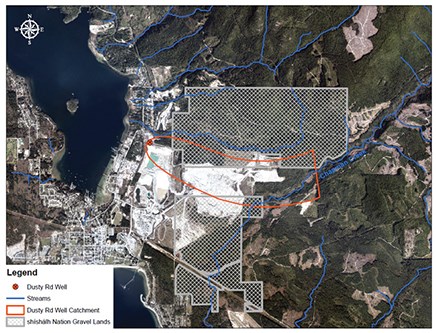Staff presented an update on the Dusty Road well to the Sunshine Coast Regional District (SCRD) board, while a group of concerned citizens calling itself the Post Group attended the Oct. 14 meeting as a delegation.
The Post Group distributed more than 2,500 pamphlets this fall criticizing the SCRD’s approach to the Coast’s water issues, and creating some public interest in the Dusty Road well site. The SCRD invited the group as a delegation.
When a test well was drilled in 2018, it was found to have the potential for a substantial yield of 64 litres per second, staff reported at the infrastructure committee meeting and again at board.
Since then, SCRD staff have identified a number of complicating factors. The area overlaps with Chapman Creek, the Sechelt Landfill, current gravel land operations and land that was transferred to shíshálh Nation and is earmarked for future gravel extraction.
Overlap with Chapman Creek could potentially draw water from the creek, requiring the SCRD to release more water from Chapman and Edwards lakes. There is also a low potential of contamination from gravel extraction and the Sechelt Landfill, Remko Rosenboom, the general manager of infrastructure services, said. The aquifer’s recharge rate may also be impacted by gravel extraction.
Although development costs were estimated at about $2 million at the time, a new estimate would be required.
From a procedural standpoint, any water licence would require the approval of the Ministry of Forests, Lands, Natural Resource Operations and Rural Development (FLNRORD) and shíshálh Nation, in accordance with the Foundation Agreement signed in 2018. Rosenboom said shíshálh Nation has not indicated support for the project to date. The province has a substantial backlog of two to three years for processing such applications, Rosenboom added.
Prioritizing Dusty Road would have an impact on other water supply and conservation projects, because of staff time required.
“I think that our success rate will be low [compared to] the amount of effort we need to put into all kinds of additional assessments, monitoring, et cetera… I think the effort that we need to put in it will be way higher than we had to put in for Church Road, given the complexity of the situation,” Rosenboom said.



